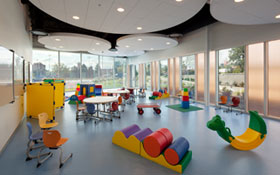Childhood Center Offers Fun Learning Spaces

ST. LOUIS — Soft exterior and interior hues, an unassuming design and an enclosed playground urface made of recycled rubber are just some of the design elements geared specifically for the young occupants of the Early Childhood Development & Parenting Education Center, located on the campus of Harris-Stowe State University in St. Louis, Mo.
Built to serve as a childcare facility, and home to Harris-Stowe’s Early Childhood Education department, the $17 million center was created to best accommodate newborn infants through pre-kindergarten children.
Designed by KAI Design & Build of St. Louis in collaboration with renowned architect, Adrian Luchini, the building incorporates a variety of unique child development areas and sustainable building elements. The center was constructed to facilitate the Reggio Emilia educational model, a form of child development that encourages learning through the five senses and through a child’s relationships with other toddlers in their unadorned environments.
KAI is currently seeking LEED Silver certification for the facility, which features a super-efficient HVAC system with an energy wheel, recycled materials, low-VOC finishes, native plant landscaping with a rain garden, and pervious pavement to reduce storm water runoff.
“The entire design of the building reflects the idea that spaces are to be a backdrop —they’re not to overshadow the children in any way,” says Donald Koppy, vice president of architecture with KAI. “Basically, the concept for the whole building was that the kids bring the color, the liveliness and the atmosphere to the play spaces.”

The 48,000-square-foot building features a front facade made of blue glass and a curved white reflective rooftop, which together bring to mind a shimmering wave. Located just past the main entrance is an enclosed outdoor play space, left exposed by a roof cutout. A portion of the play area remains covered by an overhang of the building’s second story, home of the higher education areas. The play area, which features a ground made of fall-protecting recycled rubber, is visible from the street through the building’s all-glass façade.
A series of circles etched into the rubber playground, each one filled with crushed recycled rubber, create activity spaces within the play area. Within some of the circles are playscapes that have been designed to accommodate each of the center’s varied age groups. Interior storage spaces secure tricycles, games and other objects of play.
“The building also has an indoor play area called the gross motor skills room,” Koppy says. “It’s a large interior area where the kids can play during very inclement weather.”
A video monitoring system allows students and parents to observe children at play from the higher-education classrooms. A direct-observation room with mirrored one-way glass is also available. Pan-tilt-zoom color cameras let teachers record the activities of children and project the videos onto computer monitors and screens within the center.
Second story floor-to-ceiling windows look down upon the play area, and children’s classrooms and teacher’s offices contain multiple windows of various sizes and heights to accommodate the occupants. A glassed-in “air-quarium”, located on the second floor near the entrance lobby, allows students and visitors to peer down into play areas directly below. The glass space, which opens at the roof, also provides natural lighting to both the second and first floors.
“The idea is that all the classrooms, including the higher education rooms, look down into the play area,” Koppy says.
The education center was designed to meet the needs of four learning groups: young children, young parents, professionals in the field of early childhood education and Harris-Stowe’s early childhood education majors. Areas for students and parents include a parent’s library and education room, a multi-purpose room with a full kitchen, student computer lounge, and a large multimedia classroom/lecture hall.
